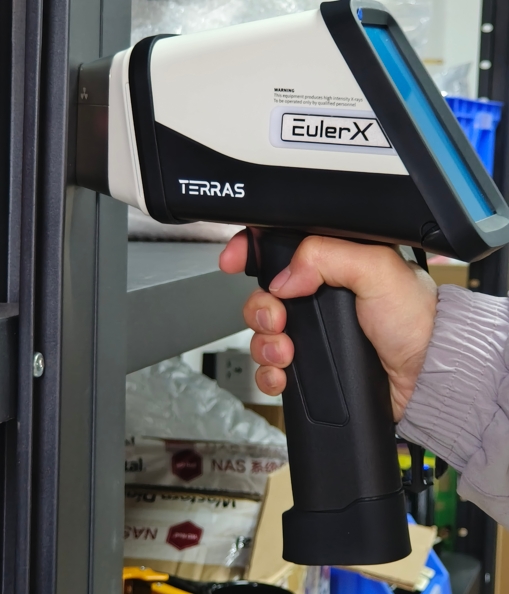
Positive Material Identification
A high-tech enterprise focusing on the development and application of X-ray technology products, committed to becoming a leading supplier of X-ray industrial testing solutions.
The Future is Portable: Handheld XRF and Its Implications in Quality Control
In the realm of quality control, advancements in technology continually revolutionize the way industries ensure the integrity and safety of their products. One such groundbreaking innovation making waves in various sectors is Handheld X-Ray Fluorescence (XRF) spectroscopy. This portable analytical tool offers a glimpse into the future of quality control, providing swift and accurate elemental analysis on the go. From manufacturing to environmental monitoring, the implications of handheld XRF are profound, promising enhanced efficiency, reliability, and compliance.

Understanding Handheld XRF
X-ray Fluorescence spectroscopy involves irradiating a sample with X-rays, causing its atoms to emit characteristic fluorescent X-rays. By detecting and analyzing these emissions, XRF can identify and quantify the elemental composition of the sample. Traditionally, XRF analysis was conducted using large, stationary instruments, requiring samples to be brought to the lab for testing. However, with the advent of handheld XRF devices, this process has been streamlined, enabling real-time analysis directly at the point of interest.
Implications in Quality Control
Manufacturing Industry: In manufacturing, ensuring the quality and consistency of raw materials is paramount. Handheld XRF empowers manufacturers to perform rapid material verification, confirming the composition of metals, plastics, and alloys instantly. This capability facilitates timely adjustments, minimizes production delays, and reduces the risk of using substandard materials.
Mining and Exploration: The mining industry benefits immensely from handheld XRF's portability and versatility. Geologists and mining engineers can swiftly analyze geological samples on-site, guiding exploration efforts more efficiently. By accurately determining the elemental composition of ore deposits, mining operations can optimize extraction processes, maximize yield, and minimize waste.
Environmental Monitoring: Handheld XRF devices play a crucial role in environmental monitoring and remediation. Whether assessing soil contamination, analyzing water quality, or identifying hazardous materials, environmental scientists rely on portable XRF for rapid field analysis. This capability expedites response times during environmental emergencies and facilitates informed decision-making in pollution control efforts.
Regulatory Compliance: Compliance with regulatory standards is non-negotiable in many industries. Handheld XRF assists organizations in meeting these requirements by providing instantaneous analysis results that adhere to established protocols. Whether verifying product specifications, assessing environmental impact, or ensuring workplace safety, portable XRF devices streamline compliance procedures and mitigate regulatory risks.
Challenges and Considerations
While handheld XRF offers unparalleled convenience and efficiency, it is essential to acknowledge its limitations and considerations:
Accuracy and Calibration: Calibration and periodic validation are crucial to maintaining the accuracy of handheld XRF devices. Regular calibration ensures reliable results and guards against instrumental drift over time.
Sample Preparation: Although handheld XRF minimizes the need for sample preparation compared to traditional methods, certain samples may still require processing to yield accurate results. Understanding sample characteristics and potential interferences is vital for obtaining reliable data.
Safety Concerns: X-ray radiation poses potential health risks, necessitating proper training and adherence to safety protocols when operating handheld XRF devices. Users must be aware of radiation exposure limits and take necessary precautions to safeguard themselves and others.
The EulerX 900 series has proved to be an excellent choice for metal analysis in a wide fields, providing fast, accurate results directly to the user. Thanks to its cutting-edge electronics and sophisticated mathematical algorithms, the EulerX 900 series ensures superior measurement quality within seconds. This makes it an ideal tool for inspecting and analyzing incoming materials, finished products, and in-process production parts in a non-destructive manner. Its simplicity of operation allows users to quickly view alloy grade and chemical composition on the touch screen display, achieving laboratory-quality analysis with minimal training and virtually no need for sample preparation, regardless of the sample is shape or size.

The applications of the EulerX 900 handheld are extensive, covering not only solids but also liquids and powders. The EulerX 900 series handheld alloy analyzers are extensively utilized for alloy grade identification and quality control, scrap metal recycling, precious metals analysis, PMI, and more.
Conclusion
The advent of handheld XRF technology heralds a new era in quality control, offering unprecedented convenience, speed, and accuracy across various industries. From manufacturing and mining to environmental monitoring and beyond, the implications of portable XRF are vast and transformative. By embracing this innovative tool, organizations can enhance operational efficiency, ensure regulatory compliance, and uphold the highest standards of quality and safety. As we continue to harness the power of portable XRF, the future of quality control grows increasingly promising, empowering industries to thrive in an ever-evolving landscape of innovation.
Join Us
Subscribe to our email list for updates & promotions.



